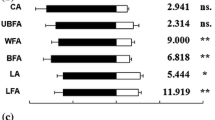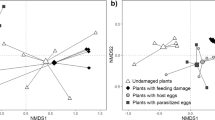Abstract
It is well documented that host-related odors enable many species of parasitoids and predatory insects to locate their prey and prey habitats. This study reports the first characterization of prey and prey host odor reception in two species of lacewings, Chrysoperla carnea (Say) and Chrysopa oculata L. 2-Phenylethanol, one of the volatiles emitted from their prey’s host plants (alfalfa and corn) evoked a significant EAG response from antennae of C. carnea. Traps baited with this compound attracted high numbers of adult C. carnea, which were predominantly females. One of the sex pheromone components (1R,4aS,7S,7aR)-nepetalactol of an aphid species, Acyrthosiphon pisum (Harris) attracted only C. oculata adults. Single sensillum recordings showed that the olfactory neurons of C. carnea responded to both 2-phenylethanol and aphid sex pheromone components, but those of C. oculata only responded to the latter.


Similar content being viewed by others
Reference
Ballal CR, Singh SP (1999) Host plant-mediated orientational and ovipositional behavior of three species of Chrysopids (Neuroptera: Chrysopidae). Biol Control 16:47–53
Boo KS, Chung IB, Han KS, Pickett JA, Wadhams LJ (1998) Response of the lacewing, Chrysopa cognata to pheromone of its aphid prey. J Chem Ecol 24:631–643
Burke HR, Martin DF (1956) The biology of three chrysopid predators of the cotton aphid. J Econ Entomol 49:698–700
Buttery RG, Ling LC (1984) Corn leaf volatiles: Identification using Tenax trapping for possible insect attractants. J Agric Food Chem 32:1104–1106
Canard M, Principi MM (1984) Life histories and behavior. In: Canard M, Semeria Y, New TR (eds) Biology of Chrysopidae. The Hague, The Netherlands, pp 57–100
Dawson GW, Griffiths DC, Merritt LA, Mudd A, Pickett JA, Wadhams LJ, Woodcock CM (1990) Aphid Semiochemicals—A review, and recent advances on the sex pheromone. J Chem Ecol 16:3019–3030
Duelli P (1980) Preovipository migration flights in the green lacewing Chrysopa carnea (Planipennia, Chrysopidae). Behav Ecol Sociobiol 7:239–246
Van Emden Hagen KS (1976) Olfactory reactions of green lacewing, Chrysopa carnea, to tryptophan and certain breakdown products. Environ Entomol 5:469–473
Flint HM, Salter SS, Walters S (1979) Caryophyllene: an attractant for the green lacewing. Environ Entomol 8:1123–1125
Hagen KS, Greany P, Sawall EF, Tassan RL (1976) Tryptophan in an artificial honeydew as a source of an attractant for adult Chrysopa carnea. Environ Entomol 5:456–468
Hooper AM, Donato B, Woodcock CM, Park JH, Paul RL, Boo KS, Hardie J, Pickett JA (2002) Characterization of (1R,4S,4aR,7S,7aR)-Dihydronepetalactol as a semiochemical for lacewings, including Chrysopa spp. and Peyerimhoffina gracilis. J Chem Ecol 28:849–864
Hubel DH (1957) Tungsten microelectrode for recording from single units. Science 125:549–550
Jubb GL, Masteller EC. (1977). Survey of Arthropods in grape vineyards of Erie County, Pennsylvania: Neuroptera. J. Econ. Entomol. 6:419–428
Keil T, Steinbrecht RA (1984) Mechanosensitive and Olfactory Sensilla of Insects. Insect Ultrastruct 2:477–515
New TR (1984) Taxonomic problems. In: Canard M, Semeria Y, New TR (eds) Biology of chrysopidae. The Hague, The Netherlands, pp 37–42
Pickett JA, Wadhams LJ, Woodcock CM (1992) The chemical ecology of aphids. Annu Rev Entomol 37:67–90
Propp GD, Tauber MJ, Tauber CA (1969) Diapause in the neuropteran Chrysopa oculata. J Insect Physiol 15:1749–1757
Srinivas SR (1988) Volatile constituents in alfalfa and red clover extracts. Dev Food Sci 18:343–353
Tauber MJ, Tauber CA (1973) Dietary requirements for mating in Chrysopa oculata (Neuroptera, Chrysopidae). Can Entomol 105:79–82
Tauber MJ, Tauber CA, Danne KM, Hagen KS (2000). Commercialization of predators: recent lessons from green lacewings (Neuroptera: Chrysopidae:Chrysoperla). Amer Entomol 46:26–38
Wong KC, Teng YE (1995) Volatile components of Lawsonia inermis L. flowers. J Essent Oil Res 7:425–428
Zhang Q-H, Birgersson G, Zhu J, Löfstedt C, Löfqvist , Schlyter F. (1999) Leaf volatiles from nonhost deciduous trees: variation by tree species, season and temperature, and electrophysiological activity in Ips typographus. J Chem. Ecol 25:1923–1943
Zhu J, Cossé AA, Obrycki JJ, Boo KS, Baker TC. (1999) Olfactory reactions of the twelve-spotted lady beetle, Coleomegilla maculata and the green lacewing, Chrysoperla carnea to semiochemicals released from their prey and host plant: electroantennogram and behavioral responses. J Chem Ecol. 25:1163–1177
Zhu J, Unelius RC, Park K-C, Ochieng SA, Obrycki JJ, Baker TC (2000) Identification of (Z)-4-Tricecene from defensive secretion of green lacewing, Chrysoperla carnea. J Chem Ecol 26:2421–2434
Acknowledgements
We thank Jennifer Harris for her assistance with the field tests, and comments from two anonymous reviewers. This project was supported by the Leopold Center for Sustainable Agriculture. Rothamsted Research received grant aided support from the Biotechnology Council of the United Kingdom
Author information
Authors and Affiliations
Corresponding author
Rights and permissions
About this article
Cite this article
Zhu, J., Obrycki, J.J., Ochieng, S.A. et al. Attraction of two lacewing species to volatiles produced by host plants and aphid prey. Naturwissenschaften 92, 277–281 (2005). https://doi.org/10.1007/s00114-005-0624-2
Received:
Accepted:
Published:
Issue Date:
DOI: https://doi.org/10.1007/s00114-005-0624-2




